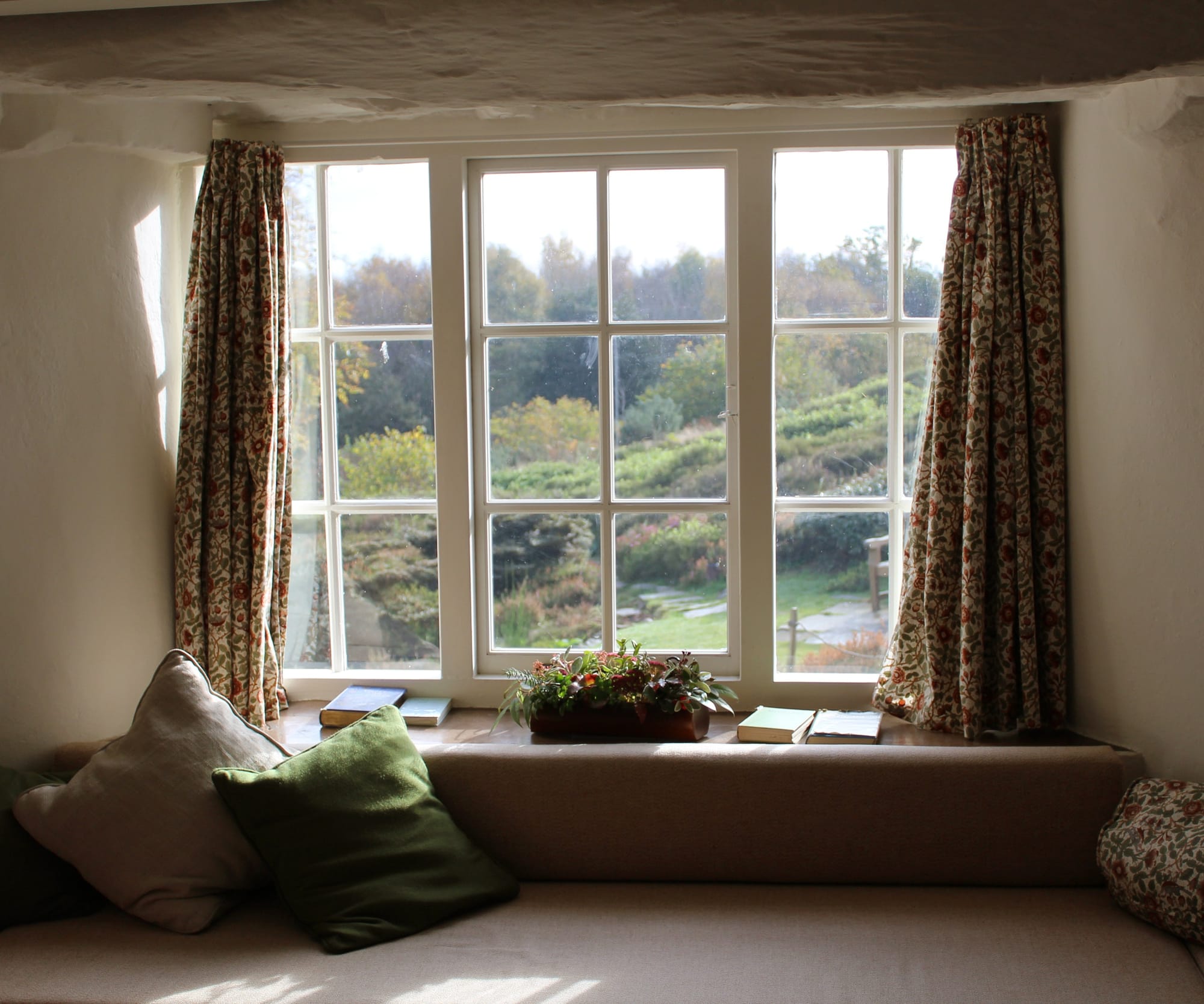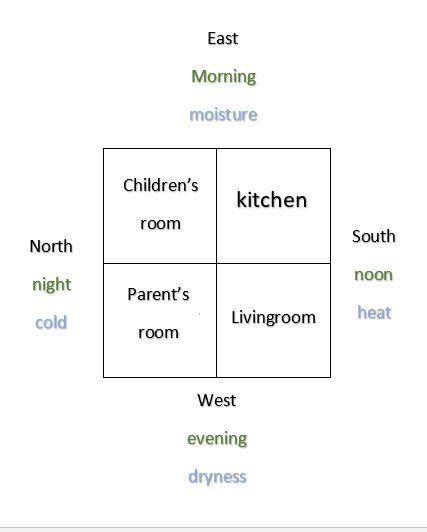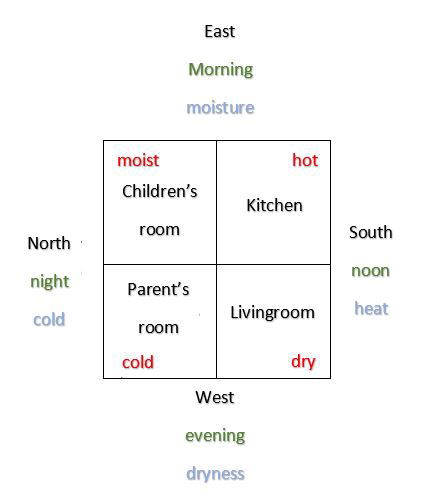Diving into Depth / the Spiritual Reasons Behind Internal Order of the 'Light in the Home' Househouse

Diving Into the Depth / the Spiritual Reasons Behind Internal Order 'Light in the Home' House
To better understand the correct division of the interior rooms - the living room, kitchen, master bedroom and children's room, four concepts must be added to the picture of the house divided according to the 'Moving Center' and the four winds, which are the main features of each of the four natural elements (water, fire, air and earth). Cold, head, moisture and dryness.
Cold is the main feature of the water element, the heat characterizes the fire element of course, the moisture belongs to the air element and the feature of the earth element is the dryness.
These features - cold, heat, moisture and dryness - are remarkably similar to the energies that each of the four winds of world bring with them, and they support the division of the rooms of the house according to the times of day (morning, noon, evening, night).
See what it looks like in the following drawing:

It should be noted that each side of the winds of the world have two qualities - its own feature, and another secondary feature, which becomes central in the next part of the day:
The night is cold and thus the cold moisture is created, so the night, associated with the north side, is cold and humid.
In the morning the cold of the night disappears and is replaced by the heat of the sun; Now the moisture from the night remains and the heat of the sun joins it, and so the rising morning in the east becomes humid and hot.
During the afternoon, when the sun moves on the south side, the heat rises and the humidity dries out, and the noon is defined as a hot, dry time.
Towards evening the heat disappears and in its place returns the cold of night. Along with the dryness that remains from noon, the evening that settles in from the west is characterized by dryness and cool.
However, if we want to hold one main feature for each side, we will refer to the features that appear in the drawing above -
The north is cold, the east - moist, the south is hot and the west dry.
The location of the rooms in the different corners of the house. Since each wind has two characteristics that define it, as stated, it turns out that each corner of the house has one character, which is shared by the two sides that join there, as can be seen in the next drawing:

The explanation for this is simple:
The northeast corner of the children’s room, is the damp corner, because both at night and in the morning there is moisture.
The southeast corner of the kitchen is the warm corner, because the heat belongs to the rising morning in the east and even dominates the noon, which is the time of the south wind.
With regard to the south-western corner of the living room which is the dry corner - the noon is characterized by dryness as a secondary feature, and the evening beginning in the west is essentially dry.
The northwest corner, where the master bedroom is located, is the cold corner as the common feature for the evening and also for the night, when the north wind blows cold.
Now you can better understand the location of the rooms in the different corners:
The damp corner is suitable for the nursery.
Moisture symbolizes freshness and youth. Children are drawn towards the experiences of ‘rebirth’, with the sun shining in the east, and the dew settling on the ground.
From our sages we learn that the child is warm and moist, both in the physical sense that his skin is full of moisture, and in the mental sense that he is flexible like a damp grass, which can bend and rise without breaking.
When children are connected to the sunrise at the beginning of the day, it is the sun which awakens them gently and gradually as it rises.
The kitchen is located in the warm corner, because through the kitchen the occupants of the house get warmth. The body does not forget for years, the food it ate when it was a child and which warmed it up.
Food is our main energy supply, but it is not just in the physical sense.
The comforting food, the smells, the melody of life with the warm voice of a mother, the flavors of spicy, sweet, sour, salty - all this choir turns the kitchen into a warm corner, at heart of the home.
And why is the living room located in the dry corner?
Dryness characterizes mental maturity. Dry material is brittle, crumbling, and able to spread to a larger surface area, implying openness, diverse connections, inspiration and creativity.
A man who is about to get married is called a man who has "reached his age." According to the Chassidic interpretation, the meaning is that his soul has reached a stage of being broken up into multiple joints and parts. The soul of a young boy is made up of one 'block' (examination of a 'point'), and therefore cannot connect with another soul, whereas a 'broken' soul indicates mental maturity and maturity for marriage.
Compared to children, parents are defined as 'dry' - both in the physical sense, their bodies are stiffer and inflexible, and in the mental-mental sense: they are more practical, grounded - proper to the earth element whose main feature is dryness, life experience, moderation and inner peace.
Although the 'dry' parents lack the boyish flexibility, they are characterized by 'dry' stability, which serves as a backbone for the flexible and shaky child.
The west side - dryness, symbolizes the time that has passed. As the day sinks and ends in the West, so do the older parents who have spent more time in their lives than the children. This is also the reason why the master bedroom is also located in the west, which brings us to the last corner -
The main essence of the living room is the conversation of adults who have come to their senses, where issues that bother the occupants of the adult house are discussed and debated.
The cold corner belongs to the parent’s bedroom.
The master bedroom is located on the northwest side - the cold place in the house.
The cold symbolizes the voice, the maturity, the ability to be matter-of-fact and not get too excited. He who gets excited from every step, changes non-stop, and in contrast a cool person is able to persevere along the way.
The north is the most suitable side of the master bedroom, as the quality time in the bedroom is actually at night, the time of the northern wind to blow in the world. Especially in winter, while the cold prevails, the body tends to look for another source of heat, and thus experiences a better connection. The external cold produces internal intimacy, as the Gemara says that winter time is best suited for sexual-connection because then "the body enjoys the body."
And why in the western corner of the north side?
Because the parents' bedroom is the place of mating, and mating is the secret of dependability, the bonding between the parents, which belongs to the cold west side.